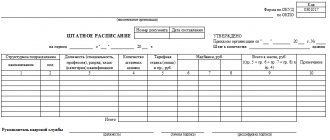Line 1520 “Accounts payable” in section V of the Balance Sheet provides information on the following types of short-term accounts payable.
1. Accounts payable to suppliers and contractors
, which is taken into account in account 60;
2. Accounts payable to employees of the organization,
which can be accounted for in the following accounting accounts:
- 70 “Settlements with personnel for wages” - in terms of accrued but not paid wages, bonuses, benefits, amounts of distributed income due to the founders - employees of the organization, etc.;
— 71 “Settlements with accountable persons” — regarding the amounts of overexpenditure on advance reports not reimbursed to employees;
- 73 “Settlements with personnel for other operations” - in terms of accrued but not paid compensation to employees for the use of personal property, amounts of financial assistance, moral damage, etc.;
- 76 “Settlements with various debtors and creditors” - in terms of amounts accrued but not paid due to the non-appearance of recipients of wages (depositors);
3. Accounts payable for compulsory social insurance ,
including arrears of contributions, taking into account fines and penalties accrued for payment to state extra-budgetary funds. These types of debt are accounted for in account 69 “Calculations for social insurance and security”.
4. Accounts payable for taxes and fees
– in particular regarding the payment of personal income tax;
wage fund in the balance sheet line
In the section Accounting, Audit, Taxes, to the question: Tell me, in what application form to the balance sheet for 2011 can I find the annual payroll? given by the author Oksana Rogozhnikova is in the cash flow statement (Form No. 4, line 160 for wages) - this is cash issued for salaries.
(This is not an accrued payroll.) These figures are not in the balance sheet. You can look... in the FSS forms.. Pen. fund You can see f. No. 5. The section “Expenses for ordinary activities” lists the organization’s expenses, grouped by elements: material costs, labor costs, social contributions, depreciation, and other costs. It should be borne in mind that the indicated elements reflect the organization’s costs associated with the write-off of inventories for the purpose of production, performance of work, provision of services, accounted wages for work performed, services rendered, accrued depreciation, etc.
Deadlines
The deadlines for submitting mandatory reporting on the wage fund are established by regulatory government bodies. Typically, reporting is submitted based on the following results:
- next quarter;
- calendar year.
Note:
When preparing reports on payroll, it is necessary to draw up a tax return for the Unified Social Tax no later than 30.03 of the year following the reporting period.
When preparing and submitting reports, the company goes through the following stages:
- The accountant sends regulatory documents establishing the form of the report and including instructions for generating reports in the automation department.
To summarize, we note that payroll is a fixed salary for employees.
The employer must pay 26% 13% (personal income tax) - the employee from his income.
Only the taxation regimes differ, but this difference is insignificant .
Didn't find the answer to your question? Find out how to solve exactly your problem - call right now:
+7 (Moscow) +7 (St. Petersburg)
In statistical and accounting reporting, labor costs separate out expenses that are not related to the wage fund and social payments. These include, in particular: travel expenses; the cost of uniforms issued free of charge, remaining for personal use, or the amount of benefits in connection with their sale at reduced prices; income from shares and other income from the participation of employees in the property of the enterprise (dividends, interest, payments on equity shares, etc.), insurance contributions to the Pension Fund, Social Insurance Fund, compulsory medical insurance funds, State Employment Fund of the Russian Federation; payments from extra-budgetary funds, in particular benefits for temporary disability, maternity, childbirth, child care, etc. [10]
Section 6 of the financial statements “Expenses for ordinary activities” (Appendix 7) provides data for the reporting and previous year on the enterprise’s expenses (excluding intra-business turnover) by economic elements: material costs, labor costs, social contributions, depreciation etc. This section contains information about the increase or decrease in work in progress balances, deferred expenses, and reserves for future expenses.
What documents are used
Information on remuneration is presented in the following documents:
- balance sheet (form No. 1) with annex (form No. 5);
- reports on income and expenses (form No. 2), on the flow of funds (form No. 4), on the intended use of money (form No. 6), etc.
How is the wage fund reflected on the balance sheet?
Salary accrual in accounting is displayed using the entry:
- Dt cch. (debit account) 20 “Main production” ( 25 “General production expenses”, 44 “Sales expenses”, etc.),
- K-t sch.
What kind of reporting is submitted?
If you are an individual entrepreneur and work in a simplified taxation system, filing payroll reports will not be particularly difficult.
Income and expenses of the wage fund are traditionally reflected in the corresponding book.
In the seventh column of the document, income received during the month and expenses that the company incurred in the same period , and the resulting difference is taken into account.
The book is submitted for control in December of each financial year.
Quarterly reporting on payroll involves filling out forms from the social insurance fund and pension fund. But there is no .
Calculation by categories of this fund is also submitted to the Pension Fund.
If this month your individual entrepreneur suffered losses , for example, income was 10 thousand rubles , and expenses were 15 thousand , in the “difference” line, indicate 1% of the amount received, the minimum profit, or simply “zero”.
If your company operates in a general taxation system , reporting will be more difficult.
You will have to draw up a balance sheet, report on funds received and losses incurred, and at the end of the reporting period, submit an appendix to the balance sheet, reports on the flow of money and the intended use of all funds.
When reporting wages, you can use the same forms as individual entrepreneurs working under a simplified method .
The only difference will be in the timing of reporting.
Labor costs in the balance sheet line
– the cost of materials used for the administrative and general economic needs of the organization (paragraph 4, paragraph 2 of PBU 5/01);
– cost of containers and packaging, cost of container materials intended for repair of containers (clauses 160, 161 of the Guidelines for accounting of inventories);
– purchased energy of all types (electric, thermal, compressed air, cold and other types), spent on technological, energy, motor and other production and economic needs of the organization (clause 20 of the Methodological Recommendations for Accounting in Agricultural Organizations, clause 4.4. 2 Instructions for the composition, accounting and calculation of costs included in the cost of transportation (work, services) of road transport enterprises (approved.
Accounting for production costs and sales costs (accounts 20 – 29, 44)” of the Guide to Information Security “Correspondence of invoices”
This is interesting: Cash loan without pension contributions
Section “Material costs” of the Information Security Guide “Correspondence of invoices”
3.5.6.1.2. What accounting data is used to fill out line 5610 “Material costs”
When filling out line 5610, data on debit turnover for the reporting year is used in the accounts of production costs and sales expenses (20 “Main production”, 23 “Auxiliary production”, 25 “General production expenses”, 26 “General expenses”, 28 “Defects”) in production”, 29 “Service production and facilities”, 44 “Sales expenses”) in correspondence with accounts 10 “Materials”, 60 “Settlements with suppliers and contractors”, 76 “Settlements with various debtors and creditors”, 94 “Shortages and losses from damage to valuables”, etc.
The amount of depreciation of an item of fixed assets as a result of revaluation is included in the financial result as other expenses. The amount of depreciation of an object of fixed assets is included in the reduction of the organization’s additional capital formed from the amounts of the additional valuation of this object carried out in previous reporting periods. The excess of the amount of depreciation of an object over the amount of its revaluation, credited to the organization's additional capital as a result of revaluation carried out in previous reporting periods, is charged to the account of retained earnings (uncovered loss).
When an item of fixed assets is disposed of, the amount of its revaluation is transferred from the organization's additional capital to the organization's retained earnings.
The amount of additional valuation of intangible assets as a result of revaluation is credited to the additional capital of the organization.
Contributions to the Social Insurance Fund
Insurance payments in case of temporary disability are calculated at a rate of 2.9% . The maximum base for these contributions to the Social Insurance Fund is considered to be reaching an amount of 670,000 rubles. After this, no deductions are made . Also, contributions for injuries . Rates depend on the types of economic activity and occupational risk classes. maximum base for these contributions. An example of calculating the amount of contributions in case of temporary disability in January will be as follows:
- Kuznetsov A.T. — 870 rubles;
- Ivanov P.N. — 1450 rubles;
- Kovaleva M.S. — 3,480 rubles.
It should be noted that in June the maximum base for Kovaleva will be reached. Contributions to the Social Insurance Fund after reaching the maximum base are not made.
Labor costs in the balance sheet line
- on line 2220, they also take into account the salaries of administrative and management personnel, if the accounting policy stipulates that the company at the end of each reporting period writes off such expenses directly to the “Cost of Sales” subaccount of account 90.
Applications and explanations
In the notes to the balance sheet and income statement, companies disclose information in the form of separate reports:
- about changes in capital;
- about cash flow.
The latest report in accordance with paragraph 29 of PBU 4/99 must characterize changes in the financial position of the company for current, investment and financial activities.
Remuneration of employees, as well as payments in their favor to third parties, are classified as current operations (subclause “d” of paragraph.
Daily, monthly and annual tariff
It is daily income that forms the basis for calculating the basic monthly salary of each individual employee and all employees of the enterprise. Basic remuneration of personnel is carried out in accordance with the tariff schedule - a set of indicators reflecting the dependence of wages on the qualifications of employees. For private enterprises, this tool is not mandatory to use, but it can be a good basis for developing your own personnel income charging system . The daily rate depends on the number of hours worked and the hourly rate. For example, a sales specialist usually performs his duties 8 hours 5 days a week. This is the most rational allocation of time, because... The legal maximum working time is 40 hours. The monthly rate will be calculated based on the daily rate, the number of working days and bonuses based on the results of the period. The annual rate is based on the average monthly rate, taking into account the annual bonus, various types of compensation, vacation pay and expenses associated with the free provision of services to employees (food, travel, etc.). As an example, let's take the executive director, sales manager and loader of Ekran LLC. The table shows the calculation of all tariffs associated with the remuneration of the listed employees. Tariffs do not include 30% tax burden (insurance contributions) and travel allowances.
| Job title | Work shift time/hourly rate | Day | Number of working days | Monthly | Other income | Annual |
| Executive Director | 8/500 | 4000 | 22 | 88000 | 100000 | 1068000 |
| Sales Manager | 8/250 | 2000 | 22 | 44000 | 60000 | 544000 |
| Loader | 10/100 | 1500 | 15 | 15000 | 25000 | 190000 |
The daily rate is equal to the product of the hourly rate by the amount of time worked, the monthly rate is calculated by multiplying the daily rate by the number of working days. The annual rate is calculated as the monthly rate multiplied by 11 months, with the addition of vacation pay and bonuses.
Labor costs in the balance sheet
Methodological recommendations for accounting of production costs and calculating production costs in agricultural organizations), or be included in the cost of production (work, services) for the relevant cost elements (material, labor costs, etc.) (Methodological recommendations for the application of the Chart of Accounts of Enterprises and organizations of the agro-industrial complex).
In the latter case, when filling out line 5630, you should take into account the debit turnover on account 28 in terms of costs in the form of contributions for social needs.
In general, the indicator in the column “For the previous year” on line 5630 is transferred from table 6 of the Explanations to the Balance Sheet and the Statement of Financial Results for this previous year.
3.5.6.3.3.
Payments to the FFOMS
Mandatory contributions are also contributions to compulsory medical insurance for employees. Paid at a rate of 5.1% . This type of contribution is transferred monthly without restrictions on the base. Calculation example Let's take the same organization and the same employees. The charges look like this:
- Kuznetsov A.T. — 1,530 rubles;
- Ivanov P.N. — 2,550 rubles;
- Kovaleva M.S. — 6,120 rubles.
Since there is no maximum base for accruals, the indicated amounts will be maintained throughout the year , in the absence of changes in wages.
Labor costs in the balance sheet line RB
Indicators of lines 5660 – 5680 of table 6 of the Explanations to the Balance Sheet and the Statement of Financial Results (fragment of table 6 of the Explanations).
Name of indicator Code For 2014 For 2013 Total by elements 5660 58,070 78,170 Actual cost of goods purchased for resale 5665 18,260 14,248 Change in balances (increase [-], decrease [+]): work in progress, 5670 (4452 ) finished products, etc. 5680 2890
Solution
Expenses for ordinary activities for 2014
- Turnover in the debit of account 26, analytical account for accounting for deductions for social needs
- Turnover in the debit of account 29, analytical account for accounting for deductions for social needs
- Turnover in the debit of account 44, analytical account for accounting for deductions for social needs
Fragment of Table 6 Explanations for 2013:
Name of indicator Code For 2013 For 2012 Contributions for social needs 5630 7718
Solution
In accounting, the list of costs included in a particular element is determined by the organization independently (taking into account industry specifics). The selected option is fixed in the accounting policy.
This is interesting: Certificate of medical examination
In order to generate information about the costs of the reporting period, debit turnovers are used in the production cost (sales expenses) accounts. In this case, internal turnover between the accounts of production costs (sales expenses), as well as turnover associated with the transfer of finished products and goods for the needs of own production, service farms, etc. (hereinafter referred to as internal turnover ) should not be taken into account.
Recalculation of the value of banknotes at the organization's cash desk and funds in bank accounts (bank deposits), expressed in foreign currency, can also be carried out as the exchange rate changes.
To prepare financial statements, the value of assets and liabilities is recalculated into rubles at the rate in effect at the reporting date.
Cash equivalents are cash and highly liquid financial investments that can be easily converted into a known amount of cash and that are subject to an insignificant risk of changes in value.
This division is required for the correct formation of the cost of sales, as well as the formation of other company expenses not related to core activities.
After the organization has accrued wages, it is required to withhold personal income tax and make posting D70 - K68. If there are any other deductions, then they must also be carried out.
The employee receives the amount minus personal income tax, the advance received and other deductions, if any (alimony, for example).
Contributions to the Pension Fund
If the employer is an individual entrepreneur, then he makes payments to the Pension Fund both for himself and for each employee . These deductions do not overlap in any way. did not change in 2015 . For the Pension Fund of Russia it is 22% . The maximum base in 2015 was set at 711,000 rubles. After reaching this amount, 10% of the employee’s salary . For entrepreneurs and organizations that operate in production conditions that are harmful and/or dangerous to the life and health of workers, there are increased contribution rates. In 2015, their size increased even more and is:
- 9 % - for the categories described in clause 1, part 1, art. 30 of the Law of December 28, 2013 No. 400-FZ “On Insurance Pensions”;
- 6 % - for the categories described in clause 2 - 18 part 1 art. 30 of Law No. 212-FZ.
When reassessing working conditions, as a result of such a check, the rate of additional contributions may be reduced from 0 to 8% , which is directly dependent on the assigned subclass of working conditions. Just like in 2014, the additional tariff is payable without restrictions on the amount of payments received by the employee. Example of calculation The organization employs three employees: Kuznetsov A.I. with a salary of 30,000 rubles, Ivanov P.N. with a salary of 50,000 rubles and Kovalev M.S. with a salary of 120,000 rubles. In January, contributions will be transferred to each employee at a rate of 22% , i.e.:
- Kuznetsov A.I. — 6,600 rubles;
- Ivanov P.N. — 11,000 rubles;
- Kovaleva M.S. — 26,400 rubles.
These calculations, provided that there are no changes in wages, will remain in place until June . In June, citizen Kovaleva reached the maximum base for payments, and further deductions will be made at a rate of 10% , i.e.
- Kuznetsov A.T. — 6,600 rubles;
- Ivanov P.N. — 11,000 rubles;
- Kovaleva M.S. — 12,000 rubles.
Reflection of the creditor in the reporting
Drawing up a “Balance Sheet” report at the end of the financial year is the direct responsibility of each organization. The creditor in Form No. 1 is reflected in the liability side of the balance sheet in the following sections:
- "Short-term liabilities";
- "Long term duties".
How to take into account debt by maturity
The difference between the sections lies in the assessment of the timing of accounts payable. The company's debt for more than 12 months must arise in “Long-term liabilities”. Accordingly, if the creditor is less than or equal to 12 months, then it is shown in “Short-term liabilities”. Repayment periods are calculated according to the terms of agreements with creditors, with the exception of calculations:
- With a budget.
- With extra-budgetary funds.
- With staff.
Payment of taxes and insurance premiums is regulated by federal and regional legislation, depending on the type. Accumulation of tax liens can lead to bank account seizure and company bankruptcy.
As for settlements with staff, delays in wages entail financial and criminal liability. This is established by Federal Law No. 272-FZ and the Labor Code.
How to calculate the credit balance
Note from the author! Balances on credit accounts that are included in balance line 1520 can only be shown in detail. This balance meets the requirements of PBU 4/99 for reporting.
For example, at the end of the year a subject has debts on payments to the budget:
"Deposited" means "deferred"
There is a queue at the window marked “Cashier” twice a month. But life introduces adjustments: one is on advanced training courses, another is studying, the third is sick, the fourth is on a business trip...
The enterprise has the right to store monetary resources in the cash register no more than a certain amount and period . Therefore, according to the procedure established by law, after three days the cashier, looking at the statement, makes a note about non-receipt (deposit) opposite the corresponding name and puts his signature. In turn, the accountant draws up a general cash order for them and enters them into account 76 (“Settlements with various debtors and creditors”) and subaccount 76-4 (“Settlements for deposited amounts”), and also draws up a register.
The funds are returned to the banking institution to the organization’s current (personal) account.
Deposit debt is one of the types of accounts payable to its employees. who, for various reasons, did not receive wages, benefits, compensation and other contractual material payments on time.
The deposited salary lies in the company's current account.
It is important to know: it must be paid upon the employee’s first request.
Deadlines for payment of debt can be established without conflict, on mutual contractual terms between the parties to the employment contract.
Below you can see an example of an operation for preparing documentation for the issuance of previously deposited funds.








